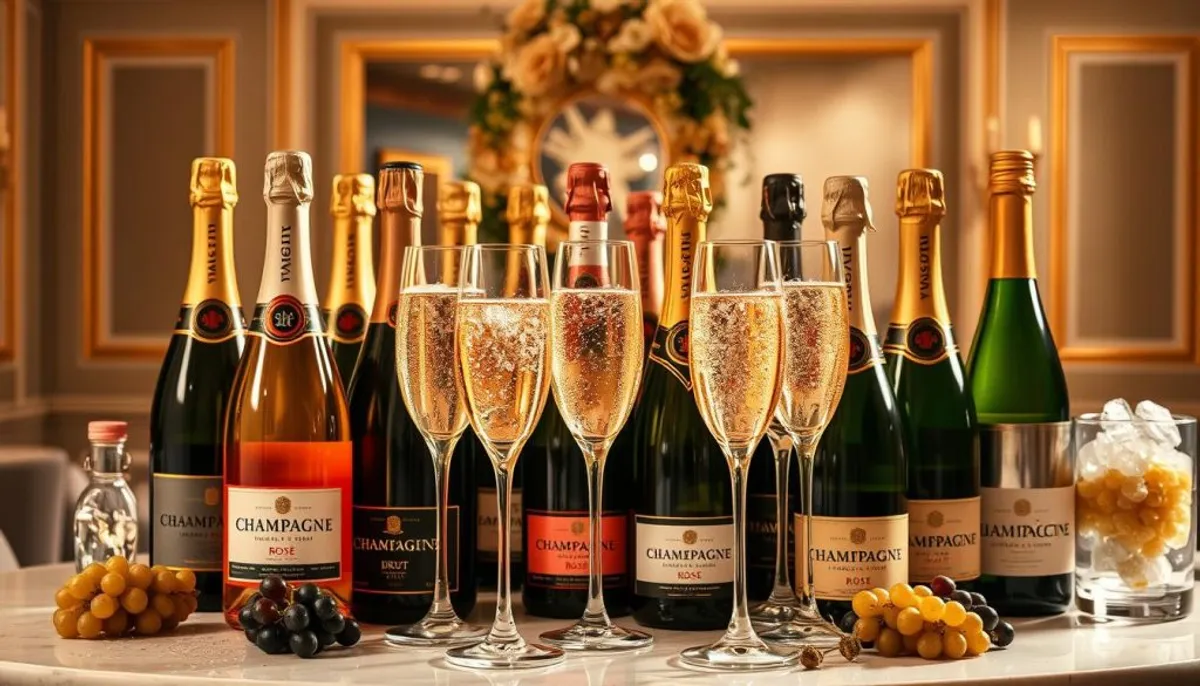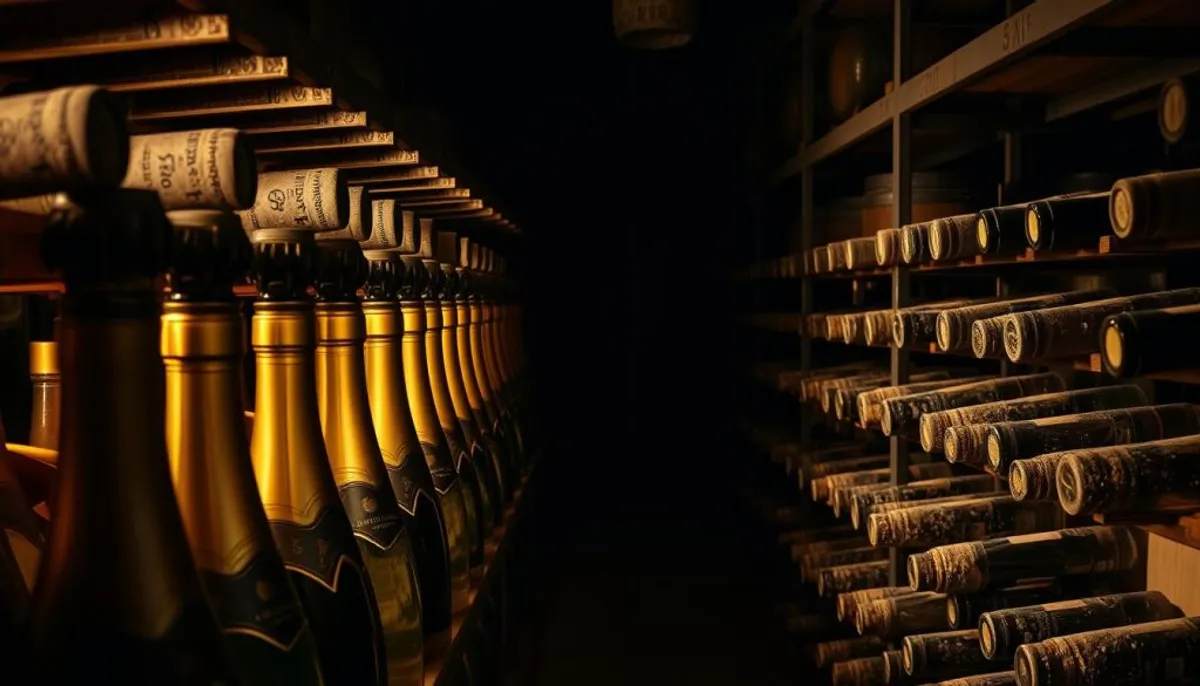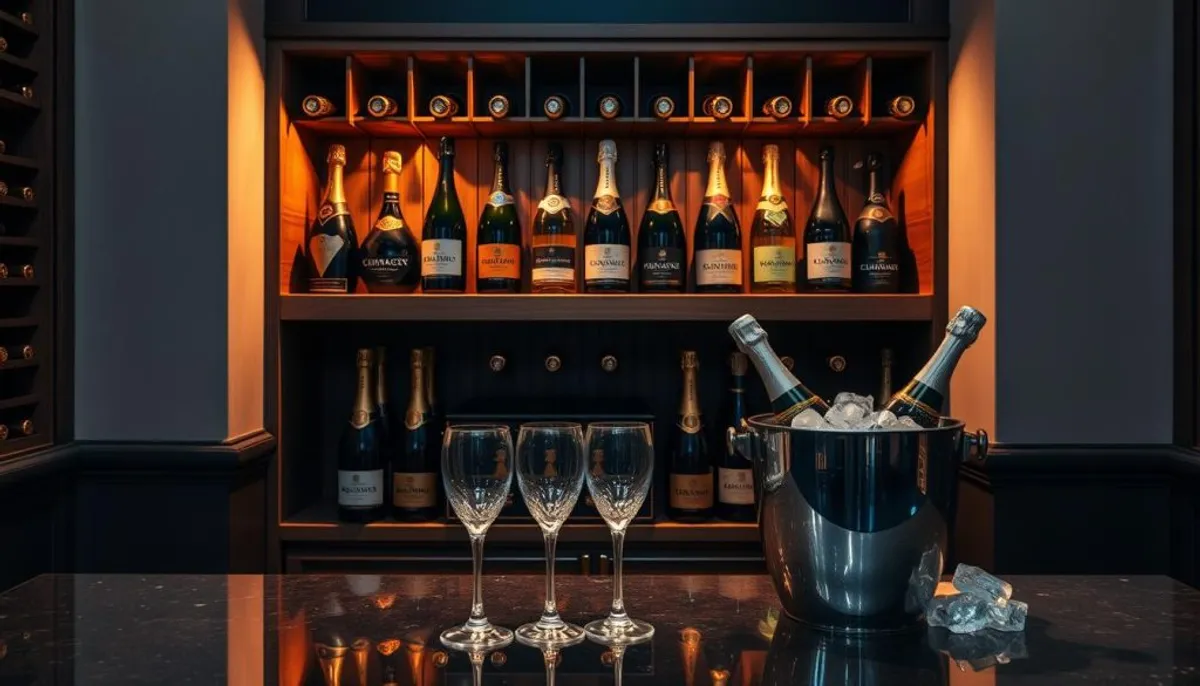Pop the cork and let’s dive into the sparkling world of Champagne! This French wine has captivated wine lovers for centuries with its bubbly charm and sophisticated allure. From the rolling hills of northern France comes a beverage that’s more than just a drink – it’s a celebration in a glass.
Champagne varieties are as diverse as they are delightful. Each sip tells a story of meticulous craftsmanship and regional pride. Whether you’re a seasoned connoisseur or a curious newcomer, understanding the nuances of this effervescent elixir will enhance your appreciation for every fizzy drop.

Did you know that true Champagne must come from its namesake region in France? It’s not just any sparkling wine – it’s a protected treasure with strict rules governing its production. The iconic méthode champenoise ensures those tiny bubbles dance in your flute, while the unique terroir imparts distinct flavors you won’t find anywhere else.
From bone-dry Brut Nature to luxuriously sweet Doux, there’s a Champagne to suit every palate. Explore the richness of Blanc de Noirs or the crisp elegance of Blanc de Blancs. And let’s not forget the blushing beauty of Rosé Champagne, perfect for romantic evenings or sunny brunches.
Key Takeaways
- Champagne is exclusively produced in the Champagne region of France
- The méthode champenoise creates Champagne’s signature bubbles
- Chardonnay, Pinot Noir, and Pinot Meunier are the primary grape varieties used
- Sweetness levels range from Brut Nature (very dry) to Doux (very sweet)
- Champagne styles include Blanc de Blancs, Blanc de Noirs, and Rosé
- Non-vintage Champagne ages for at least 15 months, while vintage ages for 3 years minimum
Introduction to Champagne and Its Protected Status
Champagne, a sparkling wine with a storied past, has long fascinated wine aficionados. The Champagne region in France, where this esteemed wine originates, boasts a winemaking heritage that spans millennia. The first recorded mention of Champagne wines dates back to 1690, initiating a journey of unparalleled significance.
What Makes Champagne Unique
Champagne’s distinctiveness is rooted in its specific production area and methodology. The advent of cork stoppers in 1685 and the introduction of thicker glass bottles in 1770 transformed Champagne’s production. These innovations were pivotal in enhancing the wine’s preservation and storage capabilities.
The Champagne Region and AOC Regulations
The Champagne region’s legal safeguard is essential to its identity. AOC regulations dictate production techniques, grape varieties, and aging periods. Today, over 70 countries acknowledge the legal status of “Champagne.” The United States, for instance, prohibits the use of “Champagne” on new U.S.-produced wines unless approved before 2006.
Traditional Production Method
The méthode champenoise, or traditional method, is fundamental to Champagne’s unique flavor and fizz. This method involves a two-step fermentation, with the second occurring in the bottle. Louis Pasteur’s discovery of yeast’s fermentation role in 1860 further perfected this technique. The introduction of cold disgorging in 1884 by Armand Walfard was another crucial step in Champagne’s production evolution.
| Year | Milestone |
|---|---|
| 1690 | First mention of Champagne wines |
| 1685 | Introduction of cork stoppers |
| 1770 | New thicker glass bottles introduced |
| 1860 | Pasteur discovers yeast’s role in fermentation |
| 1884 | Cold disgorging method invented |
Different Types of Champagne by Sweetness Levels
Champagne sweetness levels are significantly influenced by the dosage added post-second fermentation. This dosage determines the sugar content, which in turn shapes the taste and character of each champagne style.
Brut Nature and Extra Brut (0-6 g/L)
These champagnes are among the driest. Brut Nature contains 0-3 g/L of residual sugar, while Extra Brut ranges from 0-6 g/L. They are ideal for those who prefer a crisp, bone-dry taste.
Brut (Less than 12 g/L)
Brut is the most sought-after style. It contains less than 12 g/L of sugar, offering a balance between dryness and subtle sweetness. This style is versatile, suitable for various occasions and food pairings, including a selection of luxury bubbly options.
Extra Sec and Sec (12-32 g/L)
Extra Sec (12-17 g/L) and Sec (17-32 g/L) are characterized by a noticeable sweetness. These champagnes pair well with desserts and fruity appetizers, enhancing their flavors.
Demi-Sec and Doux (32-50+ g/L)
Demi-Sec (32-50 g/L) is semi-sweet, while Doux (50+ g/L) is the sweetest champagne. These styles complement rich desserts and blue cheeses, adding a delightful sweetness to the palate.
| Style | Sugar Content (g/L) | Calories (5 oz) | Carbs (g) |
|---|---|---|---|
| Brut Nature | 0-3 | 0-2 | Up to 0.15 |
| Extra Brut | 0-6 | 0-6 | Up to 0.9 |
| Brut | 0-12 | 0-7 | Up to 1.8 |
| Extra Dry | 12-17 | 7-10 | 1.8-2.6 |
| Dry | 17-32 | 10-19 | 2.6-4.8 |
| Demi-Sec | 32-50 | 19-30 | 4.8-7.5 |
| Doux | 50+ | 30+ | 7.5+ |
Primary Grape Varieties in Champagne Production
The essence of Champagne lies in its three primary grape varieties: Chardonnay, Pinot Noir, and Pinot Meunier. These grapes, each with its own distinct characteristics, come together to form the renowned sparkling wine.
Chardonnay, a white grape, holds a significant 28% of Champagne’s vineyards. It is celebrated for its elegance, finesse, and freshness. Chardonnay-dominant champagnes often display delicate white fruit aromas and a balanced acidity.
Pinot Noir, the most planted variety, occupies 38% of the vineyards. This red grape adds structure, body, and complexity to the champagnes. It imparts aromas of red fruits, such as cherry and strawberry, along with subtle spicy notes.
Pinot Meunier, another red grape, makes up 31% of the vineyard area. Known for its vigor and disease resistance, it produces fruity champagnes with aromas of pear and apple. Pinot Meunier contributes roundness and fruitiness to the blend.
| Grape Variety | Vineyard Coverage | Key Characteristics |
|---|---|---|
| Chardonnay | 28% | Elegance, finesse, white fruit aromas |
| Pinot Noir | 38% | Structure, body, red fruit notes |
| Pinot Meunier | 31% | Fruitiness, roundness, yellow fruit aromas |
The art of blending these varieties in varying proportions is crucial to creating balanced and complex champagnes, including various luxury bubbly options. Each house guards its unique blend ratio as a trade secret, preserving its distinct style and identity.
Blanc de Blancs and Blanc de Noirs Styles
Champagne aficionados often distinguish between Blanc de Blancs and Blanc de Noirs. These styles highlight the distinct traits of specific grape varieties in champagne production.
Blanc de Blancs: Pure Chardonnay Expression
Blanc de Blancs, or “white from whites,” is a white champagne crafted solely from Chardonnay grapes. It presents a refined and crisp character, with floral and citrus nuances. The Côte des Blancs region is celebrated for its exquisite Blanc de Blancs, showcasing the Chardonnay grape’s potential.
Blanc de Noirs: Black Grape Mastery
Blanc de Noirs, meaning “white from blacks,” is produced from black grapes, mainly Pinot Noir and Pinot Meunier. This style offers a more robust white champagne with red fruit undertones. The Montagne de Reims is famous for its Pinot Noir, contributing to outstanding Blanc de Noirs.
Flavor Profiles and Characteristics
These styles present distinct flavor profiles and textures. Blanc de Blancs is typically lighter and more refined, whereas Blanc de Noirs is richer and fruitier. The following table outlines the key differences:
| Characteristic | Blanc de Blancs | Blanc de Noirs |
|---|---|---|
| Grape Variety | Chardonnay | Pinot Noir and/or Pinot Meunier |
| Body | Light and delicate | Fuller-bodied |
| Flavor Profile | Floral and citrus notes | Red fruit flavors |
| Notable Region | Côte des Blancs | Montagne de Reims |
Rosé Champagne: The Pink Perfection
Rosé Champagne has transcended its former status as a mere party accessory, now cherished by aficionados. It now represents 8.5% of Champagne consumption in Europe and 11.5% in the United States. This surge in popularity is a stark contrast to the 1970s, when it barely made up 5% of total production. When it comes to brunch cocktails, finding the best champagne for mimosas can elevate your experience.
Production Methods
In Champagne, rosé production employs two primary techniques. The first involves champagne blending, where red and white wines are meticulously combined. The second method entails brief skin contact with red grapes. These methods yield a variety of pink shades and distinct flavor profiles.
Taste Profile and Food Pairings
Rosé Champagne presents a broad spectrum of flavors, ranging from subtle strawberry to robust cherry. It harmoniously blends fruitiness with the crispness of white wine grapes. This versatility makes it an ideal companion for a wide array of dishes, from light appetizers to substantial main courses.
| Brand | Price (USD) | Tasting Notes |
|---|---|---|
| Laurent-Perrier Cuvée Rosé | 100 | Crisp red fruit flavors |
| Veuve Clicquot Rosé | 70 | Full-bodied with berry notes |
| Louis Roederer Brut Rose | 130 | Elegant with citrus undertones |
| Billecart-Salmon Brut Rose | 130 | Delicate with hints of wild strawberries |
Rosé Champagne typically boasts an alcohol content of 11-14% ABV. Prices span from $20 for La Baume Brut Rose of Pinot Noir to $130 for premium labels like Louis Roederer and Billecart-Salmon. The intricate production process often leads to a 10-20% premium over blanc counterparts, highlighting the craftsmanship that goes into these pink masterpieces.
Vintage vs Non-Vintage Champagne
The champagne world is divided into vintage and non-vintage categories. Vintage champagne is crafted from grapes of a single, outstanding year. It undergoes a minimum of 3 years of aging, which enhances its complex flavors and distinct traits. On the other hand, non-vintage champagne blends grapes from various years to maintain a consistent taste, aging for at least 15 months.
About 20% of champagne production is vintage, made only in the finest years. It captures the essence of the harvest’s terroir and climate, offering a unique taste profile. In contrast, non-vintage champagne, which constitutes 80% of production, ensures consistency and broader availability.

The aging process is vital in developing champagne’s taste. Vintage champagne’s longer aging contributes to its higher price and superior quality. Its higher acidity and pronounced structure also make it highly sought after by collectors and connoisseurs, enhancing its aging potential.
| Characteristic | Vintage Champagne | Non-Vintage Champagne |
|---|---|---|
| Production | 20% of total | 80% of total |
| Grapes | Single year harvest | Blend of multiple years |
| Minimum Aging | 3 years | 15 months |
| Flavor Profile | Complex, unique | Consistent house style |
| Aging Potential | Higher | Lower |
Champagne houses like Dom Pérignon and Krug are renowned for their vintage offerings. Whether opting for vintage or non-vintage, both provide delightful experiences for champagne aficionados.
The Major Champagne Houses and Their Signatures
The champagne world is a tapestry of historic brands and luxury offerings. From iconic houses to small-scale growers, each producer adds a unique flavor to the sparkling wine landscape. When searching for the best champagne for mimosas, this exploration delves into the diverse range of champagne brands that define this prestigious industry.
Historic Maisons
Renowned champagne houses like Moët & Chandon, Veuve Clicquot, and Bollinger have been perfecting their craft for centuries. These luxury champagne producers are celebrated for their consistent quality and distinctive styles. Moët & Chandon, founded in 1743, is renowned for its Dom Pérignon vintage champagne. Veuve Clicquot’s Yellow Label Brut, on the other hand, embodies harmony and finesse.
Grower Champagnes
Grower champagne offers a distinct approach to production. These wines are crafted by smaller estates using grapes from their own vineyards. Labeled as RM (Récoltant-Manipulant), grower champagnes provide unique, terroir-driven expressions. They highlight the diversity of Champagne’s sub-regions and often offer excellent value for money.
Notable Prestige Cuvées
Prestige cuvées represent the zenith of champagne production. These luxury champagnes, such as Dom Pérignon and Cristal, are crafted in limited quantities and command premium prices. They embody the finest expressions of a house’s style and are often aged for extended periods before release.
| Champagne House | Signature Style | Notable Cuvée |
|---|---|---|
| Moët & Chandon | Balanced and elegant | Dom Pérignon |
| Veuve Clicquot | Full-bodied and Pinot Noir-driven | La Grande Dame |
| Louis Roederer | Structured and complex | Cristal |
Champagne Regional Classifications and Terroir
The Champagne region is characterized by a diverse array of vineyards, each with its own distinct terroir. Spanning approximately 35,000 hectares, it encompasses 319 villages. The region’s varied subregions significantly influence the flavor profiles of its wines.
Montagne de Reims
Renowned for its Pinot Noir grapes, Montagne de Reims is home to the most Grand Cru villages in Champagne. The terroir here produces full-bodied champagnes, renowned for their rich flavors.
Côte des Blancs
Côte des Blancs is celebrated for its Chardonnay grapes. The chalky soils in this subregion contribute to the creation of elegant, mineral-driven wines. These grapes are frequently used in Blanc de Blancs Champagnes, characterized by their lemon and apple notes.
Vallée de la Marne
Vallée de la Marne is the primary domain of Pinot Meunier. This grape variety imparts fruitiness and roundness to champagne blends. The area’s unique terroir is instrumental in crafting complex, balanced wines.
| Subregion | Main Grape | Soil Type | Wine Style |
|---|---|---|---|
| Montagne de Reims | Pinot Noir | Chalk, Limestone | Full-bodied |
| Côte des Blancs | Chardonnay | Chalk | Elegant, Mineral |
| Vallée de la Marne | Pinot Meunier | Clay, Stone | Fruity, Round |
Champagne’s vineyard classification includes 42 Premier Cru and 17 Grand Cru vineyards. These classifications, combined with the unique terroir of each subregion, are pivotal in defining the distinct flavors and qualities of Champagne wines.
Serving and Storage Recommendations

Ensuring the right storage and serving conditions is essential for the enjoyment of champagne. Store your champagne in a cool, dark environment with a temperature between 10-12°C (50-54°F). The ideal humidity should be between 60-70 percent. It’s important to keep bottles away from strong odors, vibrations, and sudden temperature changes to maintain their quality.
To serve champagne optimally, chill it to the correct temperature. Non-vintage bruts are best at 45-48°F (7-9°C), while vintage cuvées can be served slightly warmer. Utilize tall, narrow champagne glasses to preserve bubbles and enhance aromatics.
| Champagne Type | Serving Temperature | Storage Duration |
|---|---|---|
| Non-vintage Brut | 45-48°F (7-9°C) | 2-3 years |
| Vintage Cuvées | 50-54°F (10-12°C) | 5-10 years |
For long-term storage, bottles should be laid horizontally or upright. The pressure inside the bottle keeps the cork moist. Aging champagne can soften its crispness while enhancing its richness and complexity. With proper care, your champagne will be ready to impress at any celebration.
Food Pairing Guide for Different Champagne Styles
Exploring champagne food pairing reveals a world of possibilities to elevate your dining experience. The champagne’s high acidity and effervescence make it an ideal match for a variety of dishes. Let’s dive into some ideal pairings for different champagne styles.
Appetizers and Light Dishes
Brut champagne pairs exquisitely with oysters, sushi, and light appetizers. Its crisp acidity cuts through rich flavors, refreshing the palate. For a luxurious start, consider pairing caviar with vintage champagne or prestige cuvées like Dom Pérignon.
Main Course Pairings
Blanc de Blancs champagne beautifully complements seafood and light poultry dishes. Its delicate flavor profile enhances subtle tastes without overpowering them. For richer dishes like duck or mushroom, opt for Blanc de Noirs champagne. Rosé champagne, with its versatility, pairs well with a broad spectrum of cuisines, including spicy Thai curries.
Dessert Combinations
Champagne and dessert can create a delightful experience. Sweeter styles like Demi-Sec pair wonderfully with fruit-based desserts. For a unique twist, try pairing fruit tarts with Demi-Sec champagne or indulge in truffle popcorn with Charles Heidsieck Brut Reserve.
| Champagne Style | Food Pairing |
|---|---|
| Brut | Oysters, Sushi, Fried Foods |
| Blanc de Blancs | Seafood, Light Poultry, Creamy Cheeses |
| Blanc de Noirs | Duck, Mushroom Dishes, Strong Cheeses |
| Rosé | Tuna, Salmon, Spicy Thai Curry |
| Demi-Sec | Fruit Tarts, Sweet Desserts |
When pairing champagne with seafood or any dish, aim to match intensity and balance flavors. Feel free to experiment with unconventional pairings. Serve your champagne at 45-50°F for the optimal tasting experience.
Conclusion
The realm of champagne is vast, offering a spectrum of styles to suit every taste and event. From the dry Brut Nature to the sweet Doux, the variety in sweetness levels is a testament to champagne’s diversity. The Brut style, making up 80% of production, finds a harmonious middle ground between dryness and fruitiness.
Delving into unique varieties like Blanc de Blancs and Blanc de Noirs enhances our appreciation for champagne. Blanc de Blancs, crafted solely from Chardonnay, boasts elegance with hints of lemon and brioche. In contrast, Blanc de Noirs, made from dark-skinned grapes, presents rich red fruit and vanilla notes. For those in search of a romantic touch, Rosé Champagne offers a charming pink hue and versatile pairing options.
In choosing your champagne, consider your budget, personal preferences, and the occasion. Whether celebrating a significant event or enjoying a casual glass, there’s a champagne to enhance every moment. With options available in specialty liquor stores and online, finding your ideal bottle is simpler than ever. So, let’s raise a glass and explore the effervescent world of champagne together!
RelatedRelated articles



